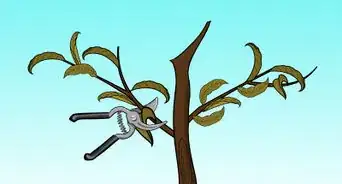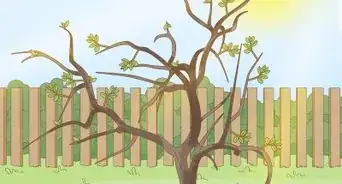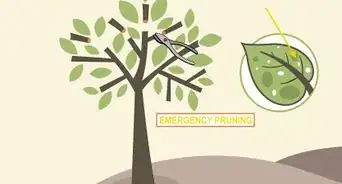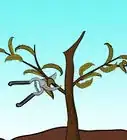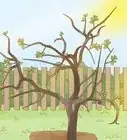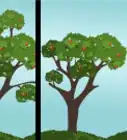This article was co-authored by Andrew Carberry, MPH. Andrew Carberry is a Food Systems Expert and the Senior Program Associate at the Wallace Centere at Winrock International in Little Rock, Arkansas. He has worked in food systems since 2008 and has experience working on farm-to-school projects, food safety programs, and working with local and state coalitions in Arkansas. He is a graduate of the College of William and Mary and holds a Masters degree in public health and nutrition from the University of Tennessee.
There are 10 references cited in this article, which can be found at the bottom of the page.
wikiHow marks an article as reader-approved once it receives enough positive feedback. This article received 31 testimonials and 94% of readers who voted found it helpful, earning it our reader-approved status.
This article has been viewed 906,145 times.
Growing fruit at home can be a rewarding experience, both in the process and the results. If you've been cultivating an apple tree and want to get maximum fruit production out of it, you've likely looked into the necessity of pruning. Pruning works to create a healthier tree, stimulate growth, and produce larger quantities and higher quality fruit over time. Don't let your tree grow into disarray as a result of neglect, take a few easy steps and prune your apple tree yourself.
Steps
Getting the Basics
-
1Know when to prune. As soon as you realize your apple tree needs pruning, it can be tempting to jump to it and start lopping off branches immediately. However, it is important to prune at the right time to avoid damaging your tree. Prune in the first month or two of spring, at least two weeks after the last frost.[1]
- If you need to, pruning can occur later in the spring and early in the summer.
- Avoid pruning in the fall, as new growth will be stimulated but will die off from the cold of winter.[2]
-
2Decide how much you need to prune. A well pruned healthy apple tree will be a poor shade tree; it should have significant spacing between branches.Advertisement
-
3Get the right tools. Pruning requires some specific tools in order to prevent damage to the tree. The blades you use to cut branches should be proportional in size to the branches you cut. For small limbs, use hand pruners. Larger branches that are about 1” thick can be cut off with loppers. Use a saw (a folding saw works well) to cut any branches wider than 3”.[3]
-
4Know which trees to prune. If your apple tree is a good shade tree, then it is an obvious candidate for pruning. However, pruning should not be done on all trees. Hold off on heavy pruning until your tree is at least three years old. If a significant amount of pruning needs to be done for a tree, do portions of it over several seasons.[4]
- Pruning young or small trees is done to encourage a strong framework and starting shape.
- Pruning large or matured trees encourages larger, healthier fruit and maintains the overall shape.[5]
Pruning Your Apple Trees
-
1Get the right shape. Your apple tree should be slightly conical in shape, with more volume near the base than at the top. This will allow sunlight to reach more of the branches. Before you begin pruning, keep in mind that you want to create a pyramid-shaped framework of branches on the tree.[6]
-
2Choose your scaffold branches. Apple trees grow with their trunk connecting to a central lead branch, and then with scaffold branches (the next largest branches) connecting to these. Viewed from the top, your tree should have only a few scaffold branches that don't cross and allow even spacing between each. Depending on the size of your tree, it should only have 2-6 primary scaffold branches. The rest should be removed.[7]
- The angle of scaffold branches is very important. Good scaffold branches will have a 45 to 50 degree angle from the trunk. If the angle is any smaller than this, the branch will likely break off from the weight of the fruit. If the angle is any larger than this, then the tree won't bear as much fruit.
- Seen from an aerial view, the scaffold branches of the tree will look similar to a star or the spokes on a wheel.
-
3Remove "suckers". Suckers are the unwanted shoots that grow near the base of the trunk. Remove all of these shoots up to the base of the main canopy of the tree to encourage a good shape. Suckers are the only part of the tree which can be pruned or removed even near the end of summer and beginning of fall.[8]
-
4Cut off any dead wood. Remove any dead, diseased or damaged wood which is flaking or discoloured. You can remove diseased, dead, or damaged wood any time of year and you should do this as soon as you notice it. Remove the whole branch if it doesn't have any buds. If it does have buds towards the base of the branch, make a cut just above an outward facing bud. Angle each cut so rain can drain off the stem rather than sitting on top and rotting the plant.[9]
-
5Cut off downwards growing branches. If there are any branches on your apple tree that grow downward, they will need to be removed. These will not be able to bear large and healthy fruit, and will take up valuable space and sunlight that other branches can use more effectively.[10]
-
6Prune down whorls. Especially common in more mature trees, whorls are locations in which three or more small branches originate from the same location. Because so many limbs are growing from the same place, the branch is weaker and unable to support the branches as they grow. Determine which is the largest and healthiest of the smaller bunch, and then cut off the remaining branches from the whorl.[11]
-
7Prune the remaining branches. Cut back the rest of the branches by about 1/3 of their length, to encourage the stems to thicken and develop flowers the following season. Make each cut just above an outward facing bud to encourage a healthy shape.
Community Q&A
-
QuestionMy golden delicious tree has a lot of straight upward branches. Should they be removed?
 Andrew Carberry, MPHAndrew Carberry is a Food Systems Expert and the Senior Program Associate at the Wallace Centere at Winrock International in Little Rock, Arkansas. He has worked in food systems since 2008 and has experience working on farm-to-school projects, food safety programs, and working with local and state coalitions in Arkansas. He is a graduate of the College of William and Mary and holds a Masters degree in public health and nutrition from the University of Tennessee.
Andrew Carberry, MPHAndrew Carberry is a Food Systems Expert and the Senior Program Associate at the Wallace Centere at Winrock International in Little Rock, Arkansas. He has worked in food systems since 2008 and has experience working on farm-to-school projects, food safety programs, and working with local and state coalitions in Arkansas. He is a graduate of the College of William and Mary and holds a Masters degree in public health and nutrition from the University of Tennessee.
Food Systems Expert Yes, you should remove them. Try to leave branches with a 45 to 50 degree angle from the trunk.
Yes, you should remove them. Try to leave branches with a 45 to 50 degree angle from the trunk. -
QuestionMy apple tree is eight years old and has never been pruned. It has not produced any fruit in the last two years. How do I prune it to correct this?
 Andrew Carberry, MPHAndrew Carberry is a Food Systems Expert and the Senior Program Associate at the Wallace Centere at Winrock International in Little Rock, Arkansas. He has worked in food systems since 2008 and has experience working on farm-to-school projects, food safety programs, and working with local and state coalitions in Arkansas. He is a graduate of the College of William and Mary and holds a Masters degree in public health and nutrition from the University of Tennessee.
Andrew Carberry, MPHAndrew Carberry is a Food Systems Expert and the Senior Program Associate at the Wallace Centere at Winrock International in Little Rock, Arkansas. He has worked in food systems since 2008 and has experience working on farm-to-school projects, food safety programs, and working with local and state coalitions in Arkansas. He is a graduate of the College of William and Mary and holds a Masters degree in public health and nutrition from the University of Tennessee.
Food Systems Expert Start by removing all dead, damaged, or diseased wood the first year. This will likely stimulate new growth and fruiting. You can prune for shape the 2nd year, but don't remove more than 1/3 of the volume of the tree at a time.
Start by removing all dead, damaged, or diseased wood the first year. This will likely stimulate new growth and fruiting. You can prune for shape the 2nd year, but don't remove more than 1/3 of the volume of the tree at a time. -
QuestionIs the beginning of May too late to prune?
 Community AnswerIn most areas, yes. Pruning should be done during the dormancy state, not where leaves or fruit are developing.
Community AnswerIn most areas, yes. Pruning should be done during the dormancy state, not where leaves or fruit are developing.
Things You'll Need
- Pruning saw or loppers
- Telescopic pruner for high branches
- Garden gloves if wished
- Safety Glasses if wished
References
- ↑ http://chemung.cce.cornell.edu/resources/pruning-apple-trees
- ↑ https://www.growveg.com/guides/how-to-winter-prune-apple-trees/
- ↑ http://www.diynetwork.com/outdoors/pruning-apple-trees/index.html
- ↑ https://extension.oregonstate.edu/news/apple-trees-benefit-proper-pruning-spring-summer
- ↑ http://www.weekendgardener.net/how-to/prune-apple-trees.htm
- ↑ https://pss.uvm.edu/ppp/articles/appleprune.html
- ↑ http://www.weekendgardener.net/how-to/prune-apple-trees.htm
- ↑ http://cesonoma.ucanr.edu/files/27164.pdf
- ↑ https://extension.umaine.edu/fruit/growing-fruit-trees-in-maine/pruning/
About This Article
To prune apple trees, wait until spring and early summer. Then, use hand pruners and loppers to cut off any downward growing branches or branches that are dead or diseased. You should also prune any suckers that are growing at the base of the apple tree. As you prune, try to maintain a slightly conical shape so the tree is thicker at the base and thinner at the top. Once you've pruned all of the unwanted branches, cut the rest of the branches back one-third of their length, which will help them thicken and grow more flowers. For more information from our Food Systems Expert co-author about how to detect diseased branches, keep reading!
